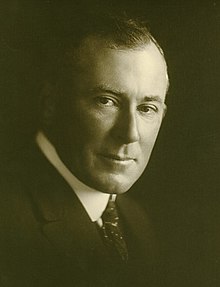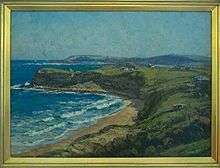Will Ashton
Sir John William Ashton, OBE, ROI (20 September 1881 – 1 September 1963) was an English-Australian impressionist artist and director of the National Art Gallery of New South Wales from 1937 to 1945.
Sir John William Ashton | |
|---|---|
 | |
| Born | John William Ashton 20 September 1881 |
| Died | 1 September 1963 (aged 81) |
| Nationality | Australian |
| Education | Académie Julian |
| Known for | Painter |
| Movement | Impressionism |
| Awards | Wynne Prize: 1908, 1930, 1939 |
Early life
Ashton was born on 20 September 1881 in Clifton, York, England, the son of James Ashton, an artist. The Ashtons migrated to Adelaide, South Australia, and he was educated at Prince Alfred College from 1889-1897. Upon graduating, Ashton entered the life of an artist. In 1900, he left for England to work, and spent 1902-1903 at the Académie Julian in Paris.[1]
Ashton had some of his works accepted by the Royal Academy of Arts, London, and the Salon de la Société des Artistes Français, and returned to Adelaide in 1905. The sale of his work, "Boulevard Montparnasse, Paris", to the National Gallery of South Australia enabled him to marry May Millman, on 31 January 1906 at Christ Church, North Adelaide. After holding exhibitions in Sydney, Melbourne, Perth, and Adelaide, in 1908, he won the Wynne Prize for landscape.[1]
In 1912-14, he painted in Britain, Europe, and Egypt. He was back in Australia for a year, but returned to London with his family in 1915 until 1917. Others of his subsequent frequent overseas trips were in the company of Lionel Lindsay or Charles Bryant.[1] The impressionist oil paintings he made on these trips always sold well on his return to Australia. He advised the National Gallery of South Australia and private collectors, and supported his family by examining for the Royal Drawing Society of which he was a member. He won the Godfrey Rivers Bequest prize in 1933 and 1938. Ashton also won the Wynne Prize for a second and third time in 1930 and 1939.[2]
Later life

In 1937, Ashton became director of the National Art Gallery of New South Wales, and almost immediately had to organize the sesquicentennial exhibition of Australian art. During his tenure, he improved the gallery lighting, but other plans were postponed because of World War II. From 1944-1947, he was also director of David Jones Art Gallery. A member of the Commonwealth Art Advisory Board from 1918, Ashton was chairman in 1953-1962. He was a member of the Royal Institute of Oil Painters, a vice-president of the Australian Painter-Etchers' Society, and a member of the Society of Artists in Sydney, being awarded its medal in 1944.[1]
He was appointed an Officer of the Order of the British Empire on 1 January 1941[3] and was made a Knight Bachelor on 11 June 1960 for his service as chairman of the Commonwealth Art Advisory Board.[4]
Ashton died of cancer at his home at Mosman on 1 September 1963. He was survived by three sons and by his second wife, Winfreda Isabel Hoggard, whom he had married on 6 February 1961. On 9 May 1989, Lady Ashton was murdered in Mosman by serial killer John Wayne Glover. A portrait of Will Ashton was painted by William Dargie and was bought by the Commonwealth government.[1]
References
- "Ashton, Sir John William (Will) (1881 - 1963)". Australian Dictionary of Biography. Retrieved 21 January 2010.
- http://www.thearchibaldprize.com.au/history/prev_winners/wynne
- "It's an Honour: OBE". Australian Government. Retrieved 21 January 2010.
- "It's an Honour: Kt". Australian Government. Retrieved 8 April 2020.
| Cultural offices | ||
|---|---|---|
| Preceded by James Macdonald |
Director and Secretary of the National Art Gallery of New South Wales 1937 – 1945 |
Succeeded by Hal Missingham |